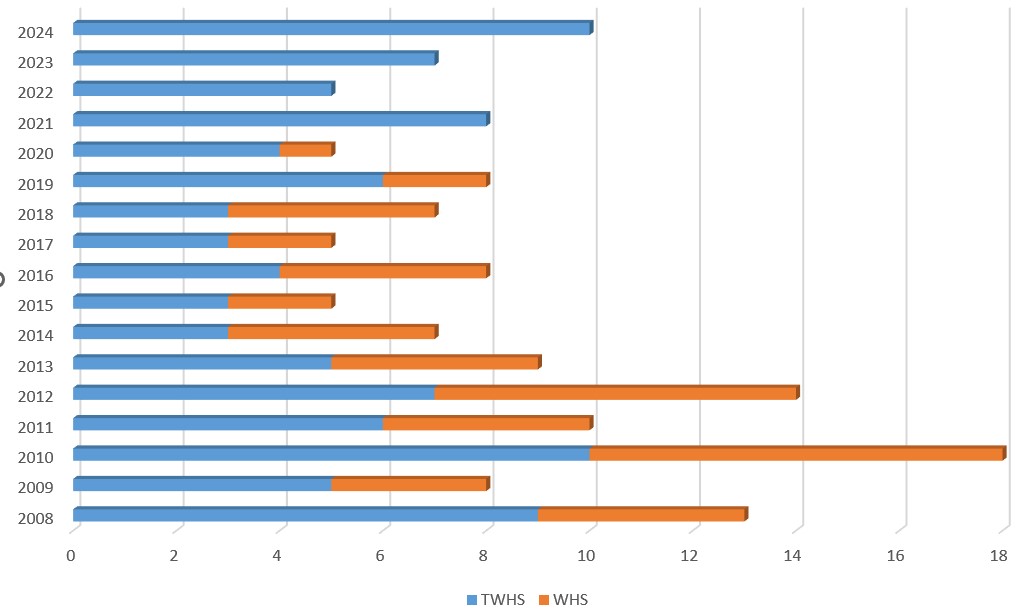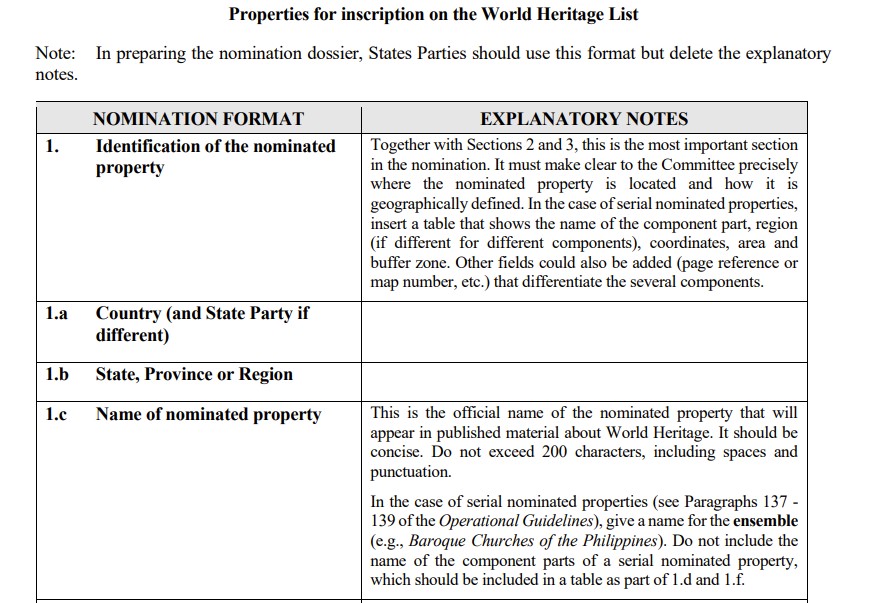Blog WHS website
Incomplete Dossiers
A few weeks ago the full set of documents for the 2023 WHC session became available online. Among them is 'Revision of the Operational Guidelines’, which examines whether the measures taken have led to a geographically more balanced list (spoiler: they didn’t). As discussed on the Forum, a root cause analysis is lacking from this document. We can point at the ‘piggybacking’ on serial transnational sites, the increasing cost of nominations, and probably a couple of other hypotheses. But my eye also fell on the high number of nominations that were deemed ‘Incomplete’ during the preparation of this year’s double session: 7 in 2022 and 10 in 2023. Can these incomplete dossiers hold a clue regarding the causes of the imbalance?
The History of Incomplete dossiers
What’s the general trend in incomplete dossiers?
The graphic below shows the number of incomplete dossiers recorded per year. The orange ones later became WHS, and the blue ones stayed on the Tentative Lists. I’d say that the number stayed relatively stable overall, with a few peaks at the start.

How does the number of incomplete dossiers vary by region?
I've compared the number of incomplete dossiers per continent with the number of sites the continent still has in the process (referred, deferred, postponed) and with the overall number that got inscribed (stemming from both directly complete and earlier incomplete dossiers). I looked from the first year when the level of completeness was reported (2008), to 2019 as that would allow me to follow their full lifecycle.
The outcome is:

So the percentage of ‘First time right’ is much higher in Europe and North America than in Africa. As shown in the last column, an incomplete dossier from Africa is outweighed by only one inscription. Europe gets almost four in the same timeframe. Also, it is clear that the African countries barely are building a pipeline of potential inscriptions.
What is the future of a once Incomplete dossier?
It may sound that an ‘Incomplete dossier’ can easily be overcome: if you know where you fell short (I guess they receive that feedback), you can improve the next year.
Do they try again, when, and do they eventually succeed? From the 112 incomplete dossiers, spanning 95 different potential sites:
- 39 never tried again within the period,
- 13 were incomplete twice or more,
- 40 sites eventually made it to an inscription within the period.
But there’s always hope, as Paraty had no less than 4 incomplete dossiers before getting inscribed.
When is a Nomination considered Incomplete?
So why do so many fail at the first hurdle? Article 128 of the Operational Guidelines explains when a dossier is considered incomplete. Now I have spent much of my professional career in Bid Management and I am very familiar with the completeness checks done before the ‘other side’ starts looking at the content: are all requested documents present, is the submission signed by an authorized person, does the text not exceed a certain amount of pages, etc.
There is some of that here as well (they still have to submit hard copies of the nomination dossier for example), but the Secretariat’s completeness check is more thorough than I anticipated. It’s a kind of pre-screening. Two particularly nasty requirements are:
- A nomination dossier shall be considered “incomplete” if it does not include clearly defined boundaries.
- The dreaded management plan or management system: A nomination dossier that does not include [these] .. documents is considered incomplete unless other documents guiding the management of the nominated property until the finalization of the management plan are provided.
The nominated site also has to be included in the State Party's Tentative List and have undergone a complete Preliminary Assessment (see Paragraphs 63, 65 and 122 of the Operational Guidelines).

Impact of Incomplete dossiers on the imbalance of the List
What we have learned from the data above:
- Incomplete dossiers are a common occurrence across all years and all continents.
- Incomplete dossiers often mean the end of a nomination process; this has been so in over 40% of the studied cases.
- The same imbalance that we see among the inscriptions we encounter in the incomplete dossiers: Europe/North America by far doing best, Africa the worst, and Latin America/Caribbean and Asia/Pacific not too great as well.
I’ve not been able to find when the tougher completeness check was introduced, but my educated guess would be around the year 2008. From then on, the expectations from a nomination dossier got higher and the process got more costly. Dossiers containing more than 1,000 pages are no exception anymore.
The underlying reason that European/North American countries are more successful in submitting complete dossiers may also lie in that they have strict domestic heritage conservation laws and land registers in place. The dossier screening process also makes it easier for classic ‘monuments’ than less easier-to-define (cultural) landscapes.
How do you look at the development of the nomination dossiers over the years?
Els - 13 August 2023